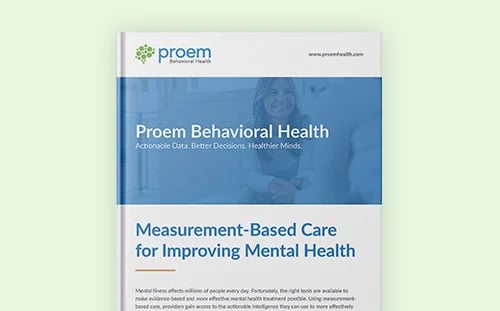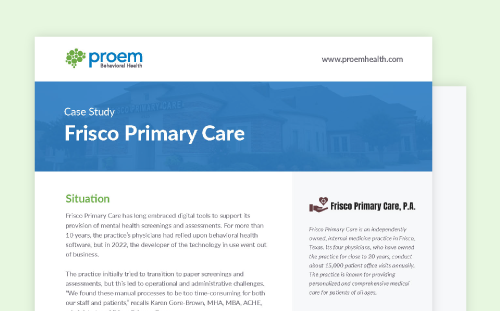
The benefits of offering integrated behavioral health in primary care are equal parts clinical, operational, and financial. Practices are poised to reduce overall utilization, increase revenue and improve patient satisfaction rates when behavioral health services are available and accessible in a familiar care setting.
Behavioral health integration is not without its challenges, though. The American Medical Association’s Moving Medicine podcast details the additional workflows that integrated care requires, from increased patient screening, care planning and follow-up to more purposeful quality and financial reporting. These complexities point to a clear need for purpose-built software to support integrated behavioral health and the shift to value-based primary care.
Primary Care: Mental Health and The Role of BHI
Research has shown it can take more than a decade for the average patient to receive a mental or behavioral health diagnosis after first discussing the issue with a doctor. Meanwhile, it’s estimated that patients discuss their mental or behavioral health in 75% of visits to primary care physicians. This suggests PCPs can play a pivotal role in identifying issues and discussing interventions at an early stage.
In supporting integrated behavioral health in primary care, practices provide interventions such as patient education, frequent check-ins, behavioral assessments and referrals to specialists. PCPs are well positioned to provide these services given their knowledge of a patient’s overall health and their understanding of how clinical symptoms may have roots in behavioral health – for example, anxiety or depression may lead to poor medication adherence.
To that end, the Centers for Medicare & Medicaid Services has noted there is often overlap in the Medicare populations eligible for its Chronic Care Management and Behavioral Health Integration (BHI) services. Though the services are distinct, practitioners may bill for both in the same month for the same patient – further highlighting the value of addressing behavioral health in primary care.
Technology’s Role in Supporting BHI
The Agency for Healthcare Research and Quality indicates “an organized clinical approach” is necessary to integrate behavioral health within primary care. This approach includes numerous functional components, including a unified care plan, treatment and referral, and patient and caregiver support. For providers of primary care, mental health clinical guidelines such as these can streamline processes.
Here, AHRQ explains, technology is a key enabler. Electronic health record (EHR) systems and their add-on components can track patients through the behavioral care journey, coordinate referrals and other forms of care team communication, support patient education efforts, and provide automated reminders for follow-up care. Additional tools can provide decision support for PCPs, enable patient self-management of care, facilitate collaboration through information exchange and communication, or provide tailored support for medication-assisted treatment. Meanwhile, the American Medical Association outlines telehealth’s potential to make integrated behavioral health more accessible through virtual options for screening, education, treatment and care coordination.
Another key benefit of what AMA describes as “digitally enabled BHI” is the potential to raise the standard of care. This includes using measurement-based patient intake and screening tools, leveraging evidence-based guidelines, integrating standard measurement tools into provider and patient-facing technologies and promoting data-driven continuous quality improvement.
The last points are important. Ongoing measurement allows practices to track patients’ symptoms, outcomes and milestones in a standardized way. Not only does this help care teams tailor treatment plans, but it also demonstrates improvement, which is a critical component of value-based primary care.
Improved Outcomes and Increased Reimbursement
The goals of providing integrated behavioral health in primary care include increasing preventive behavioral health screening, addressing behavioral health concerns sooner and improving clinical outcomes. This has been linked with diagnoses of both behavioral health and chronic health conditions, and it has been demonstrated to improve care coordination, especially in supporting self-management and providing links to social services.
Proem’s clinical workflow software helps primary care practices screen, monitor and manage more patients for common behavioral health conditions within their existing clinical processes. Decision support helps practitioners make a diagnosis in minutes instead of years, while robust clinical documentation ensures practices accurately bill for every integrated behavioral health service they provide.
For many providers of primary care, mental health has traditionally been difficult to address. Integrated behavioral health in primary care may seem like a tall order for practices that are pressed for time and resources. However, the right technology tools can encourage a higher standard of care through increased information sharing, collaboration and care management. To find out more about how the Proem workflow solution can support the delivery of BHI, book a meeting.





.png)









